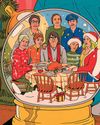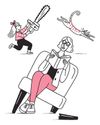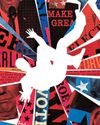The work of Rackstraw Downes and Malcolm Morley.

His “passion for facts, his desire for exactitude, makes for a sort of urgent dryness, an excruciatingly low-keyed, almost insensible skin-of-the-teeth element of poetry in his painting.” That’s from a lecture by the English born, radically realist American painter— and fine critic—Rackstraw Downes, who has a show of new landscapes, cityscapes, and interiors at the Betty Cuningham Gallery. He was discussing the seventeenth-century Dutch master Pieter Jansz. Saenredam and his paintings of church interiors, which can appear starchy and bland at a glance but, with contemplation, secrete an uncanny intensity.
Downes’s own meticulously descriptive pictures of the woebegone subjects that he favors—industrial zones, Texas deserts, highway structures, the New Jersey Meadowlands—do that, too, with a deadpan restraint that has kept his fan base small but ardent throughout the half century of his career. I’m a member. We cherish Downes’s evidence that painting can be truer than photography to the ways that our eyes process the world: reaping patches of tone and color which our brains combine very rapidly, but not instantly, into seamless wholes. He renders everything in his specialty of long, low panoramas, often encompassing more than a hundred and eighty degrees, which he always paints—on-site, over many sessions— head on, without either perspectival organization or fish-eye distortion. His avoidance of charm in his subjects and suppression of expressiveness in his touch serve the dumbfounded wonderment you can feel when—perhaps rarely enough, in this frantic era—you stop somewhere, look around, forget yourself, and only see. Downes’s is a puritanical passion, burning cold rather than hot but no less fiercely for that.
Diese Geschichte stammt aus der September 24, 2018-Ausgabe von The New Yorker.
Starten Sie Ihre 7-tägige kostenlose Testversion von Magzter GOLD, um auf Tausende kuratierte Premium-Storys sowie über 8.000 Zeitschriften und Zeitungen zuzugreifen.
Bereits Abonnent ? Anmelden
Diese Geschichte stammt aus der September 24, 2018-Ausgabe von The New Yorker.
Starten Sie Ihre 7-tägige kostenlose Testversion von Magzter GOLD, um auf Tausende kuratierte Premium-Storys sowie über 8.000 Zeitschriften und Zeitungen zuzugreifen.
Bereits Abonnent? Anmelden

YULE RULES
“Christmas Eve in Miller’s Point.”

COLLISION COURSE
In Devika Rege’ first novel, India enters a troubling new era.

NEW CHAPTER
Is the twentieth-century novel a genre unto itself?

STUCK ON YOU
Pain and pleasure at a tattoo convention.

HEAVY SNOW HAN KANG
Kyungha-ya. That was the entirety of Inseon’s message: my name.

REPRISE
Reckoning with Donald Trump's return to power.

WHAT'S YOUR PARENTING-FAILURE STYLE?
Whether you’re horrifying your teen with nauseating sex-ed analogies or watching TikToks while your toddler eats a bagel from the subway floor, face it: you’re flailing in the vast chasm of your child’s relentless needs.

COLOR INSTINCT
Jadé Fadojutimi, a British painter, sees the world through a prism.

THE FAMILY PLAN
The pro-life movement’ new playbook.

President for Sale - A survey of today's political ads.
On a mid-October Sunday not long ago sun high, wind cool-I was in Harrisburg, Pennsylvania, for a book festival, and I took a stroll. There were few people on the streets-like the population of a lot of capital cities, Harrisburg's swells on weekdays with lawyers and lobbyists and legislative staffers, and dwindles on the weekends. But, on the façades of small businesses and in the doorways of private homes, I could see evidence of political activity. Across from the sparkling Susquehanna River, there was a row of Democratic lawn signs: Malcolm Kenyatta for auditor general, Bob Casey for U.S. Senate, and, most important, in white letters atop a periwinkle not unlike that of the sky, Kamala Harris for President.